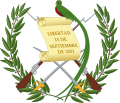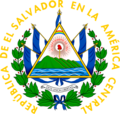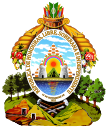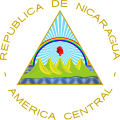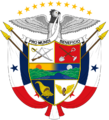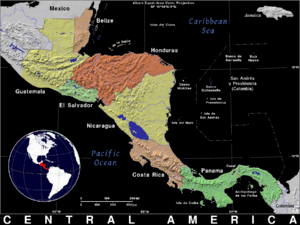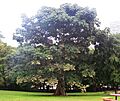Central America facts for kids
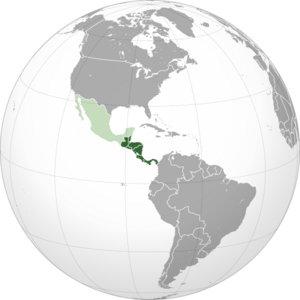 |
|
| Area | 523,780 km2 (202,230 sq mi) |
|---|---|
| Population | 52,700,000 (2023) |
| Population density | 100.6/km2 (261/sq mi) (2023) |
| GDP (nominal) | $362.62 billion (exchange rate) (2023) |
| GDP (PPP) | $738.8 billion (2023) |
| GDP per capita | $6,880 (exchange rate) (2023) $14,019 (PPP) (2023) |
| Demonym | Central American |
| Countries | |
| Dependencies | |
| Languages | |
| Time zones | UTC−06:00 to UTC−05:00 |
| Largest cities |
|
| UN M49 code | 013 – Central America419 – Latin America and the Caribbean019 – Americas001 – World |
Central America is a special part of North America. It connects Mexico to the north with Colombia to the southeast. To its east is the Caribbean Sea, and to its southwest is the Pacific Ocean.
This region is usually made up of seven countries: Belize, Costa Rica, El Salvador, Guatemala, Honduras, Nicaragua, and Panama. Central America is known for its amazing variety of plants and animals, called a biodiversity hotspot. It also has many active volcanoes and experiences frequent earthquakes.
Long ago, before Europeans arrived, different groups of native people lived here. After Christopher Columbus' voyages, Spain began to take control of these lands. From 1609 to 1821, most of Central America was ruled by Spain from Mexico City.
On August 24, 1821, New Spain (which included much of Central America) became independent from Spain. Soon after, on September 15, 1821, Central America also declared its freedom. Some parts joined the First Mexican Empire for a short time. But in 1823, they formed their own country, the Federal Republic of Central America, which lasted until 1838.
In 1838, Costa Rica, Guatemala, Honduras, and Nicaragua became independent countries. El Salvador followed in 1841, Panama in 1903, and Belize in 1981. Even though the Federal Republic of Central America broke apart, many people in countries like Costa Rica, El Salvador, Guatemala, Honduras, and Nicaragua still feel a strong "Central American" identity. People from Belize often feel more connected to the Caribbean, while Panamanians often feel more connected to South America.
Contents
Countries of Central America
Central America is home to seven unique countries. Each has its own flag and coat of arms, showing its history and culture.
Flags of Central America
Coats of Arms of Central America
Geography of Central America
Central America is a narrow strip of land that connects North and South America. It has the Gulf of Mexico and the Caribbean Sea to the east, and the Pacific Ocean to the west.
This region has over 70 active volcanoes. Forty-one of these are in El Salvador and Guatemala. The most active volcano is Santa María, which has been erupting frequently since 2013.
Central America also has many mountain ranges. The longest ones include the Sierra Madre de Chiapas, the Cordillera Isabelia, and the Cordillera de Talamanca. The highest point is Volcán Tajumulco in Guatemala, which is 4,220 meters (13,850 ft) tall.
Here are some of the highest points in each country:
| Country | Name | Elevation | Range |
|---|---|---|---|
| Doyle's Delight | 1,124 m (3,688 ft) | Maya Mountains | |
| Cerro Chirripó | 3,820 m (12,530 ft) | Cordillera de Talamanca | |
| Cerro El Pital | 2,730 m (8,960 ft) | Sierra Madre de Chiapas | |
| Volcán Tajumulco | 4,220 m (13,850 ft) | Sierra Madre de Chiapas | |
| Cerro Las Minas | 2,780 m (9,120 ft) | Sierra Madre de Chiapas | |
| Mogotón | 2,107 m (6,913 ft) | Cordillera Isabelia | |
| Volcán Barú | 3,474 m (11,398 ft) | Cordillera de Talamanca |
Between the mountains, there are fertile valleys. These valleys are great for raising animals and growing crops like coffee, tobacco, and beans. Many people in Honduras, Costa Rica, and Guatemala live in these valleys.
The weather in Central America is affected by Trade winds. Temperatures are highest just before the summer rainy season. They are lowest during the winter dry season, when the trade winds bring cooler air.
Amazing Biodiversity
Central America is part of the Mesoamerican biodiversity hotspot. This means it has a huge variety of life, holding 7% of the world's total biodiversity!
Many migratory birds fly through Central America. This is because its narrow shape acts like a funnel, guiding birds from North to South America. You can see huge numbers of birds here, especially in spring and autumn.
Because it connects two continents, Central America has species from both North and South America. The southern countries like Costa Rica and Panama have more biodiversity. The northern countries like Guatemala and Belize have less, and the central countries have the least.
Here's a look at the different species found in each country:
| Country | Amphibian species |
Bird species |
Mammal species |
Reptile species |
Total terrestrial vertebrate species |
Vascular plants species |
Biodiversity |
|---|---|---|---|---|---|---|---|
| Belize | 46 | 544 | 147 | 140 | 877 | 2894 | 3771 |
| Costa Rica | 183 | 838 | 232 | 258 | 1511 | 12119 | 13630 |
| El Salvador | 30 | 434 | 137 | 106 | 707 | 2911 | 3618 |
| Guatemala | 133 | 684 | 193 | 236 | 1246 | 8681 | 9927 |
| Honduras | 101 | 699 | 201 | 213 | 1214 | 5680 | 6894 |
| Nicaragua | 61 | 632 | 181 | 178 | 1052 | 7590 | 8642 |
| Panama | 182 | 904 | 241 | 242 | 1569 | 9915 | 11484 |
Over 300 species of plants and animals in the region are in danger. One hundred seven of these are critically endangered. The main problems are deforestation (forests being cut down) and the breaking up of rainforests. About 80% of Central America's natural plant life has already been turned into farmland.
To help protect nature, many ecoregions and nature reserves have been created. Belize has one of the largest protected areas systems in the Americas. About 36% of its land and 13% of its ocean territory are protected.
The Mesoamerican Barrier Reef System is a huge coral reef that stretches from Mexico to Honduras. The Belize Barrier Reef is part of this system. It is home to many different plants and animals, making it one of the most diverse ecosystems in the world. So far, only about 10% of the species in the Belize barrier reef have been discovered!
Central American Forests
-
Montecristo National Park, El Salvador
-
Maderas forest, Nicaragua
-
Monteverde Cloud Forest Reserve, Costa Rica.
-
Parque Internacional la Amistad, Panama
-
Petén–Veracruz moist forests, Guatemala
Between 2001 and 2010, about 5,376 square kilometers (2,076 sq mi) of forest were lost in Central America. In 2010, Belize had 63% forest cover, Costa Rica 46%, Panama 45%, Honduras 41%, Guatemala 37%, Nicaragua 29%, and El Salvador 21%.
Montane Forests
The Central American pine-oak forests are found in the mountains of Central America and southern Mexico. These forests are between 600–1,800 metres (2,000–5,900 ft) high. They have many trees like oak, pine, fir, and cypress.
Laurel forests are a common type of cloud forest in Central America. They are usually found above 1,000 meters (3,300 ft) sea level. These forests have trees like evergreen oaks and members of the laurel family. The cloud forest in Sierra de las Minas, Guatemala, is the largest in Central America.
The Central American montane forests are found at even higher altitudes, from 1,800–4,000 metres (5,900–13,100 ft). These forests get a lot of rain, especially in the warm summer.
Amazing Animals
These forests are home to many unique animals. Almost half of the birds in the Talamancan montane forests of Costa Rica and Panama are found nowhere else. Some birds, like the beautiful resplendent quetzal, are threatened.
Many amphibians (like frogs and toads) are also unique to these forests. The golden toad, which lived in the Monteverde Reserve, has not been seen since 1989 and is now considered extinct. Scientists are not sure why it disappeared, but climate change might have played a role.
Large animals like Jaguars, cougars, spider monkeys, tapirs, and anteaters also live in Central America's forests. The Central American red brocket is a type of deer found here.
National Flowers and Trees
Each country in Central America has its own national flower and tree, representing its natural beauty.
National Flowers
-
Lycaste skinneri, Guatemala
-
Izote flower, El Salvador
-
Plumeria, Nicaragua
-
Prosthechea cochleata, Belize
National Trees
-
Enterolobium cyclocarpum, Costa Rica
-
Tabebuia rosea, El Salvador
-
Calycophyllum candidissimum, Nicaragua
-
Swietenia macrophylla, Belize
-
Ceiba, Guatemala
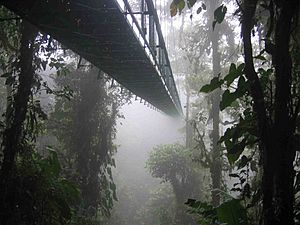
Languages of Central America
The main language in most Central American countries is Spanish. However, in Belize, the official language is English.
Many Mayan languages are also spoken here. Guatemala officially recognizes 21 of these languages. Other languages like Xinca, Miskito, and Garifuna are also spoken in Central America.
Here's a look at the languages spoken in Central America (2010 data):
| Rank | Country | Population | % Spanish | % Mayan languages |
% English | % Xinca | % Garifuna |
|---|---|---|---|---|---|---|---|
| 1 | Guatemala | 17,284,000 | 64.7% | 34.3% | 0.0% | 0.7% | 0.3% |
| 2 | Honduras | 8,447,000 | 97.1% | 2.0% | 0.0% | 0.0% | 0.9% |
| 3 | El Salvador | 6,108,000 | 99.0% | 1.0% | 0.0% | 0.0% | 0.0% |
| 4 | Nicaragua | 6,028,000 | 87.4% | 7.1% | 5.5% | 0.0% | 0.0% |
| 5 | Costa Rica | 4,726,000 | 97.2% | 1.8% | 1.0% | 0.0% | 0.0% |
| 6 | Panamá | 3,652,000 | 86.8% | 0.0% | 4.0% | 0.0% | 0.0% |
| 7 | Belize | 408,867 | 49.8% | 8.9% | 70.0% | 0.0% | 7.0% |
Culture of Central America
Central America has a rich and diverse culture, influenced by its indigenous roots, Spanish history, and Caribbean connections.
Art in Central America
Delicious National Dishes
Each country in Central America has its own special dishes that are loved by locals and visitors alike.
-
Baleada Honduras
-
Pupusa El Salvador
-
Sancocho Panama
-
Gallo pinto Costa Rica
-
Nacatamal Nicaragua
-
Rice and beans Belize
-
Pepián Guatemala
- Central American music
- Central American cuisine
- List of cuisines of the Americas – Central American cuisine
Sports in Central America
Sports are very popular in Central America, with many regional competitions.
- Central American Games
- Central American and Caribbean Games
- The first 1926 Central American and Caribbean Games happened in 1926.
- Central American Football Union
- Surfing is also a popular sport along the coasts.
Images for kids
-
The Great Blue Hole off the coast of Belize is a popular place for ecotourism. It is a UNESCO World Heritage Site.
-
Semuc Champey, Guatemala.
-
The city rail in La Ceiba, Honduras, is one of the few remaining passenger train services in Central America.
-
Ancient footprints of Acahualinca, Nicaragua.
-
Tazumal, El Salvador.
-
Tikal, Guatemala.
-
Copán, Honduras.
-
Lycaste skinneri, the national flower of Guatemala.
-
Coatepeque Caldera, El Salvador.
-
Lake Atitlán, Guatemala.
-
Mombacho volcano, Nicaragua.
-
Jiquilisco Bay, El Salvador.
-
Roatán, Honduras.
-
Tamarindo, Costa Rica.
-
Cayos Zapatilla, Panama.
See also
 In Spanish: América Central para niños
In Spanish: América Central para niños









